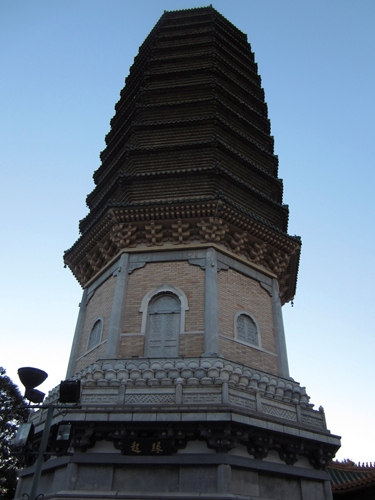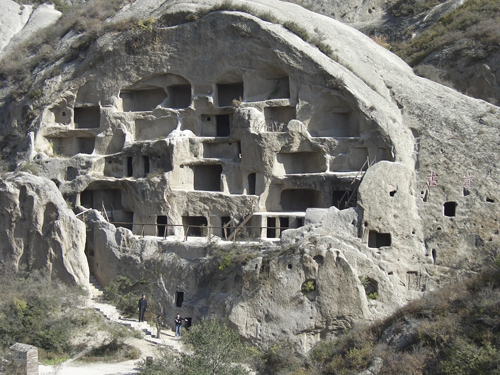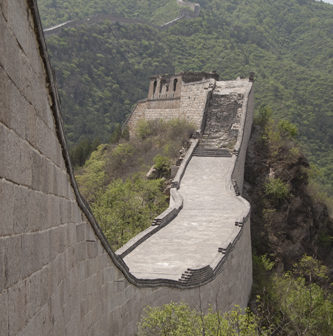Huanghuacheng 黄花城
If your idea of relaxation is losing yourself in the mountains, far away from the madding crowd on a crumbling rampart covered with flowers in bloom, then Huanghuacheng is for you. Huanghuacheng literally means “yellow flower city” after the swath of yellow flowers that blankets the site in summer. The hike starts at Jintang Lake and the crescent-shaped Huanghuacheng Reservoir, which breaks the Great Wall into three sections. The hiking trail is accessible from a raised walkway, but keep an eye out for the giant carp flopping around near the sides. Huanghuacheng is also known as Shuichangcheng (“Water Great Wall”) because part of the wall is underwater. After paying the RMB 3 “entry fee” levied by farmers, walk up the trail until you get to a ladder; climb up to start your exploration of the Great Wall. Proceed with caution; some sections require negotiating nearly 45° inclines, loose bricks, and plunging descents. On a clear day, you’ll be rewarded with soaring views, shadows playing over the mountains, and invigorating winds. Huanghuacheng is about 11km in total; at the eighth guard tower or so, there’s a little path that leads to the base of the mountain. Walk 1km along the side of the road until you get to a village; you can catch a bus back to Huairou Bus Station. Leave by 3.30pm to avoid missing the last bus.
Recommended ages: 14+ (or active younger kids aged 10+)
To do: Hike along an unrestored section of the Great Wall
Good to know: Be very careful. Parts of Huanghuacheng are quite steep and don’t have any walls or battlements to hold on to. Scattered watchtowers provide temporary relief from the sun, but a high-SPF sunscreen, hats, sunglasses, hiking shoes, and layered clothing are essential. There are no washrooms on the Great Wall, so take care of “business” before heading up. Though it’s possible to get there by bus, hire a private car to get the most out of your day. The ride can get quite bumpy, so those prone to carsickness should go with a driver to have the option of stopping.
Admission and opening hours: The only “admission” price is a RMB 3 fee levied by farmers at the entrance to the hiking trail. Similarly, there are no opening hours to speak of.
Address and contact: Xishuiyu, Jiuduhe Township, Huairou District (6165 1111/1818) 怀柔区九渡河镇西水峪
Distance: 60km (3 hours by bus, 1 hour and 45 minutes by car)
Getting there
Bus: Take the 916 express bus (916快) from Dongzhimen; tickets cost RMB 12. Get off at the last station, Huairou Bus Station (怀柔汽车站). You’ll be beset by drivers clamoring to take you to the Great Wall; hire a car or walk 600m southwest to another bus stop (cross Fuqianjie Dongjie 府前街东街 to get there). Look for unmarked buses going to Shuichangcheng (水长城), then get off at Huanghuacheng Reservoir station (黄花城水库). Tickets cost RMB 8. You’ll find the entrance to Huanghuacheng about 100m in front of you, which says ironically enough, “This section of the Great Wall is closed to visitors.”
Car: From Fourth Ring Road, catch the Jingzang Expressway (京藏高速). At Xiguan Roundabout (西关环岛), take the third exit to the Jingyin Expressway (京银高速). Turn right at Changchi Lu (昌赤路), drive for 7km, then turn right again at Huaichang Lu (怀长路). After 16km, turn left on Anxi Lu (安西路) and follow the road until you see Huanghuacheng on your right.

Badachu 八大处
Badachu (“Eight Great Sites”) takes its name from the eight Buddhist temples that make up the area’s main attraction. Though most of the temples’ names and embodiments date from the Ming and Qing Dynasties, Badachu’s history as a site of worship can be traced all the way back to the Tang Dynasty (618-907 AD). The first of the eight temples, Chang’an Si (长安寺) is actually located right outside the park. The second temple, Lingguang Si (灵光寺), is Badachu’s main attraction and the only one that still has monks-in-residence. Lingguang Si features the 13-storey Buddha Tooth Pagoda, which the faithful circle at least three times for good luck. Take the nearby chairlift (RMB 30) or continue exploring the temples on foot: Sanshan’an (三山俺), Dabei Si (大悲寺), Longwang Tang (龙王堂), Xiangjie Si (香界寺), Baozhu Dong (宝珠洞), and Zhengguo Si (证果寺). There is another chairlift and a slide (RMB 40) near Baozhu Dong. For many, however, Badachu’s temples are an afterthought; the area’s hiking trails, spectacular views, and craggy peaks are distraction enough.
Recommended ages: 3+
To do: Visit Buddhist temples
Good to know: Of the eight temples, five have teahouses where you can refresh yourself with a quick drink. Two of the temples have adjacent lodgings.
Admission and opening hours: RMB 10. Daily 5am-7.30pm (summer), daily 6am-6pm (winter).
Address and contact: Badachu Lu, Shijingshan District (8896 4661)
Distance: 19km (1.5 hours by bus, 40 minutes by car)
Getting there
Bus: Take bus 972 from Pingguoyuan subway station, bus 347 from Xinjiekou, bus 389 from Yuquan Lu, or bus 958 from Shijingshan Amusement Park.
Car: From West Fourth Ring Road, exit at Dinghui Beiqiao (定慧北桥). Go west on Tiancun Lu (田村路) past West Fifth Ring Road and turn north on Badachu Lu (八大处路).
Shengquan Mountain 圣泉山
Located 6km from the town of Huairou, Shengquan (“Holy Spring”) Mountain is sandwiched between Hongluo Temple and Mutianyu Great Wall. Highlights include an active Buddhist temple, vendors selling local products, a petting zoo with rabbits, deer, sheep, and goats, and several easy hiking trails around the mountain. Non-hikers can catch a bus ride to the top (RMB 15 one way, RMB 30 roundtrip). You’ll see waterfalls, shrines, temples, caves, a suspension bridge, gourds on the vine, and – once you reach the top – a sea of clouds weaving between the mountains.
Recommended ages: All ages
To do: Experience an active Buddhist temple
Good to know: The best way to reach Shengquan Mountain is by car. Hiking trails are one of the park’s main attractions, but families with younger children can spend the day ambling along Shengquan’s stroller-friendly paved walkways.
Admission and opening hours: RMB 26, RMB 13 (students), free for kids under 1.2m. Daily 6.30am-8.30pm.
Address and contact: Koutou Village, Qiaozi Township, Huairou District (6063 7288/9, shengquanshan@126.com) www.bjshengqs.com 怀柔区桥梓镇口头村
Distance: 70km (5 hours by bus, 1 hour by car)
Getting there
Bus: Take bus 916 or 936 from the Dongzhimen long-distance bus station to Huairou Beidajie (怀柔北大街). Then, switch to a mini-bus bound for Shengquan Mountain.
Car: Take the Jingcheng Expressway (京承高速) until you reach Huairou Qiao (怀柔桥). Switch to Jingmi Lu (京密路) and drive north for about 1.3km. Turn left at Huaichang Lianlu (怀昌联路), then right on Nanhua Dajie (南华大街). After 1.3km, turn left on Qingchun Lu (青春路) and drive until you reach a roundabout. At the roundabout, take exit 3 to Huaihuang Lu (怀黄路) and drive for 6.4km until you reach the destination. Shengquan Mountain will be on your right.

Longqing Gorge 龙庆峡
Longqing Gorge is known for the Longqing Gorge Ice Sculpture Festival in the winter and peaceful mountain vistas in the summer. Often compared to the Yangtze River’s famous Three Gorges, Longqing Gorge also ranks favorably with Guilin’s mountain and water vistas. Visitors can ride the world’s longest chain of escalators (surrounded by a bright yellow dragon-shaped shell, no less). The five-minute ride takes you to the reservoir behind the dam; from there, you can catch a 30-minute boat ride down the river (longer tours can be arranged). Besides sightseeing, tourists can bungee jump, zip line, kayak, rock climb, go horseback riding, and go-karting. Hundred Flowers Cave or Baihua Dong (百花洞) is best avoided, as the only sign of “flowers” are dusty plastic replicas. For those with plenty of energy to spare, combine this day trip with a morning visit to neighboring Badaling Great Wall.
Recommended ages: 5+
To do: Take the world’s longest chain of escalators
Distance: 85km (8 hours by bus, 1.5 hours by car)
Good to know: This is not a stroller-friendly day trip. Longqing Gorge is usually a few degrees cooler than Beijing, so pack extra layers of clothing. Small restaurants by the Longqing Gorge parking lot serve cheap and filling home-style dishes. Longqing Gorge is reachable by bus, but the trip is very long; save yourself the trouble and hire a driver instead.
Admission and opening hours: RMB 40 (park admission), RMB 40 (all access), RMB 20/50 (students). Daily 8am-9pm. Address and contact: Longqing Xia, Yanqing County (6919 1020) 延庆县龙庆峡
Getting there
Bus: From Deshengmen subway station, take bus 919 to Yanqing Station (延庆站). Catch a cab to the gate of Longqing Gorge (RMB 20, about 15 minutes).
Car: Take the Badaling Expressway (八达岭高速公路), get off at the Yangqing Exit (延庆出口), and follow the signs for Longqing Gorge.

Ancient Cliff Dwellings (Guyaju) 古崖居
About 90km north of Beijing, there’s a network of cave dwellings carved into the side of stone hills. It’s generally believed that the Xiyi ethnic minority built the caves during the Tang Dynasty (AD 618-907), but not much is known about why or how they did this – or what made them leave. Although access to the 147 caves is mostly restricted to the lower dwellings, the largest cover more than 20sqm and are made up of multiple rooms. Kids will enjoy wiggling into the smallest ones, which have just enough room to lie down in. At the peak, there is a great view of the lake and surrounding valley. Guyaju only takes one or two hours to tour, so this day trip can be combined with a visit to nearby Longqing Gorge.
Recommended ages: 4+
To do: Climb through a mysterious network of caves
Good to know: There aren’t any restaurants or vendors nearby, so pack a picnic and bring lots of water. Though Guyaju is reachable by bus, we recommend hiring a driver. Ample parking is available.
Admission and opening hours: RMB 40, RMB 20 (students), free for kids under 1.2m. Daily 8am-4pm.
Address and contact: Dongmenying Village, Zhangshanying Town, Yanqing County (6911 0333) 延庆县张山营镇东门营村
Distance: 90km (8 hours by bus, 2 hours by car)
Getting there
Bus: On weekdays, take bus 919 from Deshengmen station to Yanqing Dacaiyuan (延庆大菜园), switch to bus 920 towards Xiaying (下营), and get off at Guyaju Lukou (古崖居路口). On weekends, express bus 919 (919快) goes directly to Guyaju.
Car: From Madian Qiao (马甸桥) on North Third Ring Road, take the Badaling Expressway (八达岭高速公路) to Yanqing (延庆), take Jingzhang Lu (金盏路) to Dongmenying Village (东门营村), then follow signs for Guyaju for about 2km.
This article originally appeared on page 40 of the beijingkids June 2015 issue. Click here to read the issue for free on Issuu.com. To find out how you can get your own copy, email distribution@truerun.com.




